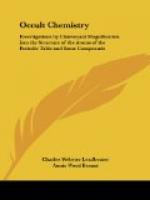Before going on with the details of the later research some very important discoveries arising from the early work must first be explained. As I have already said clairvoyant faculty of the appropriate order directed to the minute phenomena of Nature is practically infinite in its range. Not content with estimating the number of minor atoms in physical molecules, the authors proceeded to examine the minor atoms individually. They were found to be themselves elaborately complicated structures which, in this preliminary survey of the whole subject, I will not stop to explain (full explanation will be found later on) and they are composed of atoms belonging to an ultra-physical realm of Nature with which the occultist has long been familiar and describes as “the Astral Plane.” Some rather pedantic critics have found fault with the term, as the “plane” in question is of course really a sphere entirely surrounding the physical globe, but as all occultists understand the word, “plane” simply signifies a condition of nature. Each condition, and there are many more than the two under consideration, blends with its neighbour, via atomic structure. Thus the atoms of the Astral plane in combination give rise to the finest variety of physical matter, the ether of space, which is not homogeneous but really atomic in its character, and the minute atoms of which physical molecules are composed are atoms of ether, “etheric atoms,” as we have now learned to call them.
Many physicists, though not all, will resent the idea of treating the ether of space as atomic. But at all events the occultist has the satisfaction of knowing that the great Russian chemist, Mendeleef, preferred the atomic theory. In Sir William Tilden’s recent book entitled “Chemical Discovery and Invention in the Twentieth Century,” I read that Mendeleef, “disregarding conventional views,” supposed the ether to have a molecular or atomic structure, and in time all physicists must come to recognise that the Electron is not, as so many suppose at present, an atom of electricity, but an atom of ether carrying a definite unit charge of electricity.
Long before the discovery of radium led to the recognition of the electron as the common constituent of all the bodies previously described as chemical elements, the minute particles of matter in question had been identified with the cathode rays observed in Sir William Crookes’ vacuum tubes. When an electric current is passed through a tube from which the air (or other gas it may contain) has been almost entirely exhausted, a luminous glow pervades the tube manifestly emanating from the cathode or negative pole of the circuit. This effect was studied by Sir William Crookes very profoundly. Among other characteristics it was found that, if a minute windmill was set up in the tube before it was exhausted, the cathode ray caused the vanes to revolve, thus suggesting the idea that they consisted of actual particles driven against




